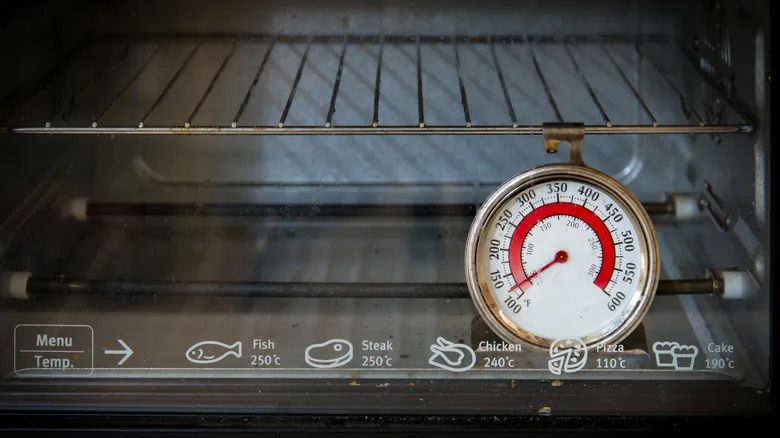Leave the thermometer alone
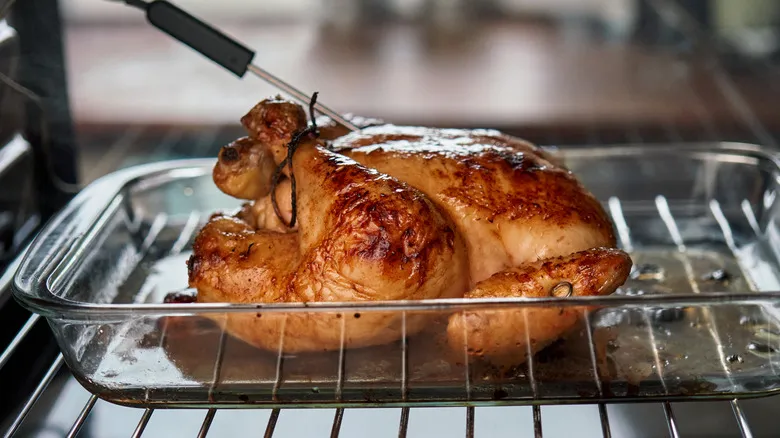
When using a food thermometer, it's crucial to set it and leave it undisturbed. This is particularly vital for effective use with meat. Constantly poking and prodding the meat while it cooks allows the juices to escape, so it's best to minimize any movement or adjustment of the thermometer. Simply insert the meat thermometer and let it be, checking it occasionally without shifting it.
"Once the thermometer is in place, it's wise to leave it alone," advises Scott Groth. "Creating multiple holes in the meat causes fats and juices to escape, increasing the likelihood of the dish drying out."
Similarly, thermometers that measure the air temperature in your oven should also be left undisturbed as much as possible. These devices are usually positioned on the rack or just inside the door to gauge the oven's environment. However, every time you open the oven to check on your food, air flows in and out, altering the temperature and potentially leading to inaccurate readings. This can complicate your ability to monitor the cooking temperature of your dish. Depending on how much the temperature drops each time the door is opened, it can significantly slow down the cooking process and delay your final result.
Don't measure the bone

When using a probe thermometer with bone-in cuts of meat, ensure that the thermometer is positioned away from the bone. Contact with the bone can disrupt the reading and provide an inaccurate assessment of your food's temperature. It's best to insert the thermometer before placing the meat in the oven, allowing you to identify the bone's location and position the thermometer accurately. The same guidelines apply when cooking poultry; steer clear of the ribs and bones. A good spot for measurement is the inner thigh, where there is ample muscle for an accurate reading without proximity to the bone.
"Remember that bones conduct heat differently than meat, which can result in misleading temperature readings," explained Scott Groth. "This may give the impression that the meat is at a safe temperature when it is actually undercooked."
If your food is undercooked, you'll likely notice it when you cut into it. For meat, this means releasing juices from the cut and possibly needing to return it to the oven if it is significantly underdone. This not only diminishes flavor but can also lead to drier meat due to the loss of juices.
Look for muscle, not fat
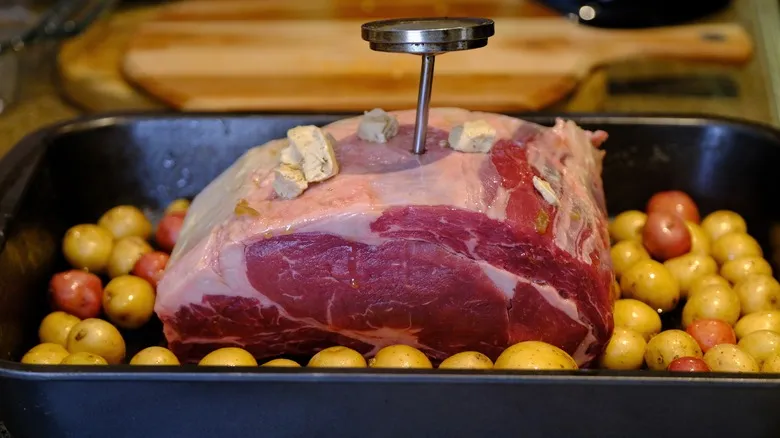
Similar to how the bone can yield an inaccurate temperature reading, the fatty areas of the meat are also not ideal for measurement during cooking. Avoid inserting the thermometer into the fatty sections, as they tend to heat up more quickly than the rest of the cut. Additionally, when fat melts, it can cause the thermometer to become less stable if placed in a large fatty area.
"Fat renders faster than the meat, transferring heat differently than the denser muscle," explained Scott Groth. "This can result in a reading that appears safe while the meat is likely still undercooked."
For optimal results, check the temperature of the muscle by inserting the thermometer where you see red or pink raw meat. Aim to insert it about halfway into the cut to measure at the center, which is typically the coolest part. Once the desired temperature is reached, the surrounding areas will also be at that temperature.
If you're working with meat that has significant marbling, there's no need to completely avoid the fat. Just ensure that you insert the thermometer into a section of the meat that contains more muscle than fat. The meat should feel firm and offer some resistance when you insert the probe, while fat will feel much softer and have a noticeably different texture.
Aim for the thickest part
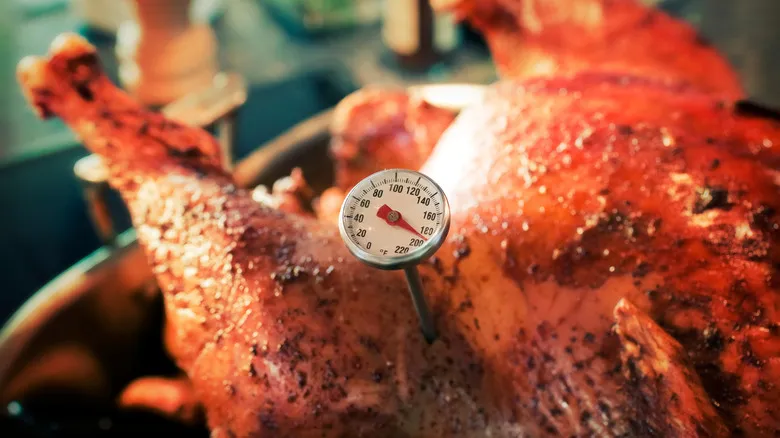
To ensure accurate cooking, you should check the internal temperature of your meat at its thickest point. Most thermometers read the temperature at the tip of the probe, so it's essential to insert it into the thickest part of the cut for the most reliable results. This area takes the longest to reach the desired temperature, ensuring your food is thoroughly cooked and minimizing the risk of food safety issues associated with undercooked meat.
The specific location for measuring temperature varies by the type and cut of meat, but Scott Groth offers a helpful guideline. He suggests, "For roasts, steaks, or roulades, inserting the probe into the thickest part will yield the best results." For poultry, such as chickens, turkeys, or ducks, the ideal spot is the inner thigh. Be sure to avoid the bone, as it can affect your readings, and focus on the thickest section that consists solely of muscle.
Additionally, achieving evenly cut steaks is crucial, especially if you have particular preferences for doneness, such as rare, medium, or well-done. When it comes to poultry, using a whole bird simplifies the measuring process, but the same principle applies to individual pieces like chicken breasts or thighs. Just remember to steer clear of the bone if you're working with bone-in cuts.
Calibrate periodically
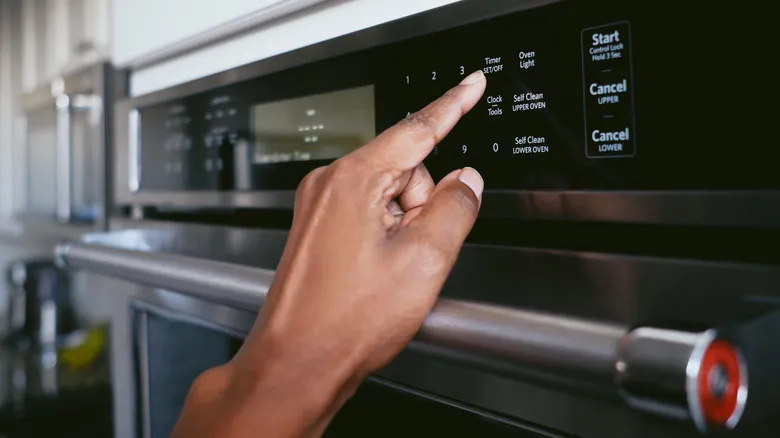
When preparing food, it's essential to ensure that your tools and appliances are accurately measuring. An unreliable thermometer that reads too high may indicate that your food is fully cooked when it isn't, resulting in undercooked meals and potential food safety risks. Conversely, if the thermometer shows a temperature lower than the actual one, you could end up overcooking and drying out your food.
Fortunately, you can maintain the accuracy of your thermometer by regularly checking it against boiling water to confirm that the temperature it displays aligns with the known boiling point of water.
"The quickest and simplest way to verify if your thermometer is properly calibrated is to immerse it in boiling water. It should read 212 degrees Fahrenheit or 100 degrees Celsius," explained Scott Groth. "This method ensures that your readings will be reliable."
Additionally, having an oven thermometer on hand is beneficial for monitoring the oven's temperature. If you set your oven to a specific temperature but the thermometer indicates a few degrees difference, you'll need to adjust your cooking accordingly. This is particularly crucial in baking, where temperature significantly affects how ingredients interact and how well certain dishes rise. The discrepancy between the set temperature and the actual temperature is referred to as "offset," which you should consider when selecting the temperature for your appliance.
Place the thermometer before cooking begins
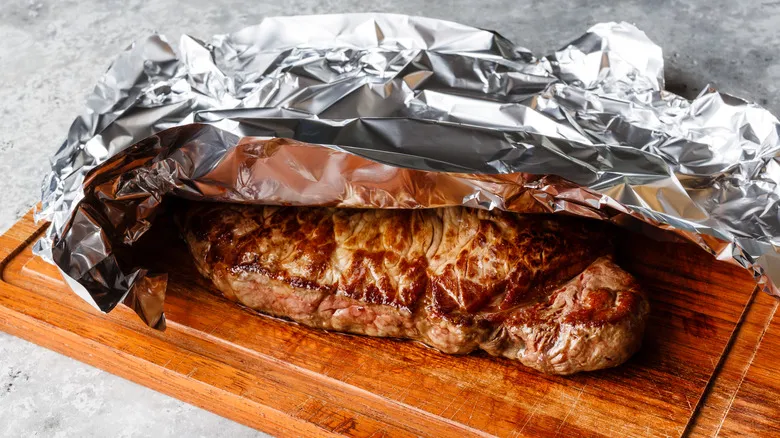
To ensure proper placement and to prevent any risk of burns, insert the oven thermometer in its designated spot before placing your food in the oven. This way, you won’t have to adjust it during cooking. Avoid removing it from the food until it has had time to rest after cooking.
For poultry such as chicken and turkey, Scott Groth advises inserting the thermometer into the thickest part right from the start and keeping it there until the cooking is complete. "The thermometer should be positioned in the poultry before cooking begins," he explains. "Once the poultry is five degrees away from being fully cooked, it can be taken out of the oven. It will continue to 'carryover cook' for 10 to 12 minutes while resting, reaching the desired doneness."
The same approach applies to steaks and other cuts of red meat. "Similar to poultry, it's best to take the dish out of the oven just before it hits the target temperature, as the residual heat will continue to cook the meat while it rests," Groth notes. Avoid removing the probe or cutting into the meat during the resting period, as this will cause the juices to escape. Instead, allow the meat to rest for 5 to 10 minutes so it can reabsorb the flavorful juices.
Use for casseroles and baking
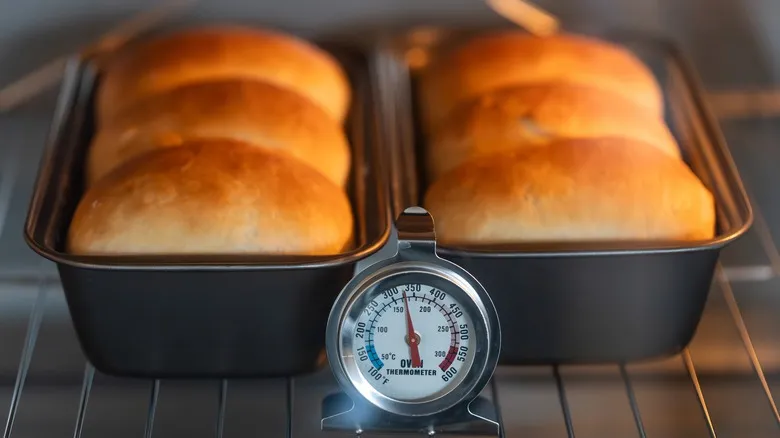
Oven thermometers are not solely for checking meat. When preparing meals for a large gathering, a probe thermometer can help you determine the doneness of casseroles, quiches, and eggs. It’s also beneficial for monitoring the oven's environment while baking.
Scott Groth shared, "In my catering business, we relied on oven probes for large quantities of breakfast strata, egg bakes, and more." Simply insert the thermometer into your dish as you would with meat and wait for it to reach the desired temperature. The U.S. Department of Agriculture (USDA) advises a minimum temperature of 160°F for egg-based dishes. Using a thermometer when cooking in bulk reduces the time spent on constant monitoring.
Additionally, you can verify the accuracy of your oven's temperature sensors before you start cooking, which can significantly impact your baking results. By using an oven thermometer to track the air temperature around items like bread or muffins, you can better gauge their doneness without having to cut them open. While inserting a thermometer into meat is effective for checking internal temperature, this method doesn’t apply to dough or batter. Instead, place an oven thermometer on a nearby rack to measure the external temperature of your oven. If your baked goods are not turning out as expected, particularly if they appear undercooked, using an oven thermometer to accurately assess the temperature is a valuable step toward improving your baking.
Keep away from heat coils
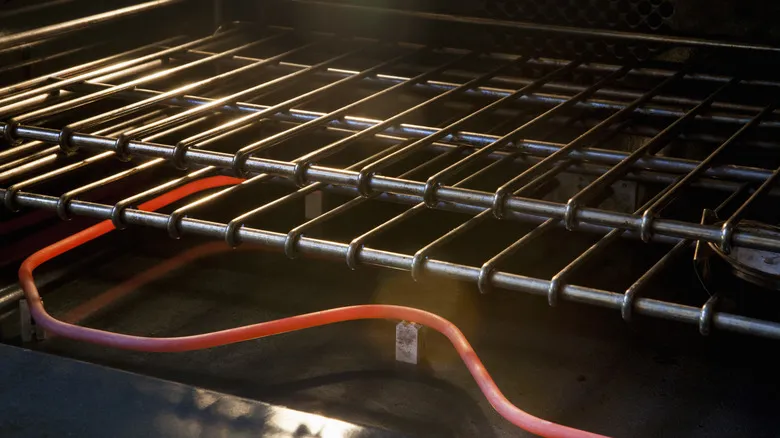
Whenever you're dealing with high temperatures in the kitchen, it's crucial to adhere to safety guidelines to prevent burns. Using an oven thermometer requires careful handling, as you'll be in proximity to intense heat and hot tools. Ensure that your thermometer is positioned away from the oven's heating coils to avoid safety hazards. This is particularly vital if your probe has its own wires, as contact between the wires and the heating element can damage both the thermometer and the oven. If you've inserted the thermometer into your dish or placed it on the oven rack before turning it on, you may need to make slight adjustments to keep it clear of the coils.
Additionally, exercise caution when removing the probe from the meat. "When taking the probe out of the meat, I prefer using heat-resistant oven gloves with fingers instead of a bulky oven mitt," says Scott Groth. "I've found that the safest method is to hold the meat with a pair of tongs in one hand while gently pulling out the thermometer with the other hand using the oven glove." You can find silicone gloves that are both heat-resistant and flexible, allowing you to handle the hot thermometer securely. It's wise to keep your oven mitt or gloves within reach throughout the cooking process.
Clean thoroughly
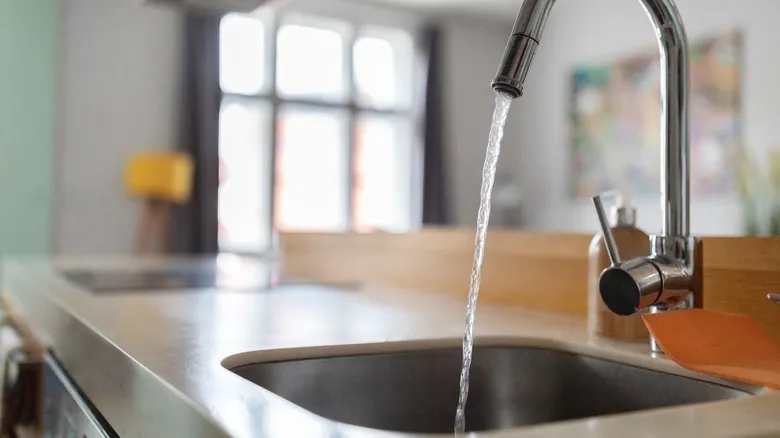
The oven thermometer requires a few minutes to cool down, but it's important to clean it before storing it away. This helps prevent the spread of bacteria that could make you ill. "After removing the probe, I place it directly in the sink to cool and wash it, allowing for quick storage," said Scott Groth. Keep in mind that the oven probe is hot, so avoid placing it near plastic dishes or utensils that could melt upon contact with this extremely hot tool.
To clean an oven thermometer, simply wash it with warm, soapy water, rinse it off, and dry it. You can either let it air dry on a rack overnight or use a towel to dry it before storing. Some thermometers come with protective cases for delicate components, particularly those with probes and wires. Ensure that the thermometer is completely dry before returning it to its storage case.
If you're new to using this tool, opt for an oven thermometer made from durable materials like stainless steel. A quality thermometer should be easy to wipe down and suitable for hand washing to maintain cleanliness. Most models are not dishwasher safe and should be cleaned by hand. Taking care of this step promptly will help extend the lifespan of your tools.
Recommended

How Many Cups Of Sugar Are In One Pound?
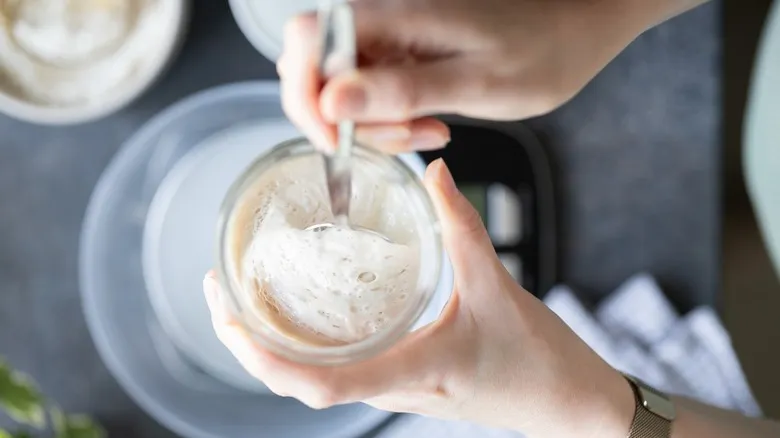
Yes, You Can Freeze Sourdough Starter. Here's How

Ina Garten Might Just Have The Answer For Your Collapsing Carrot Cake

Can You Substitute Chocolate Chips For Baking Chocolate?
Next up

